Review of Card Payments Regulation 3. Developments in the Card Payments Market
Issues Paper
March 2015
Download the complete Document 949KB
This chapter sets out the main developments in card payments and the broader Australian payments system over the past two decades or so, including the role of the Bank's reforms in influencing outcomes.
Changes in the Use of Payment Methods
Over the last two decades there has been a marked increase in the absolute and relative use of debit and credit/charge cards in Australia (Graph 1). Card payments account for over 60 per cent of the number of non-cash payments in the economy, and card networks play an important role in determining the overall efficiency of the payments system.

Overall, the value of card transactions in Australia has grown at an annual rate of 8.8 per cent since 2002, well above the average growth of 6 per cent in household consumption, indicating that the ‘death spiral’ that some observers predicted would result from the Bank's reforms did not eventuate. The cards market continued to innovate, including the implementation of EMV chip cards and the introduction of ‘contactless’ (tap/wave) authentication for lower-value transactions. In particular, the adoption of contactless technology in Australia has been among the highest in the world.
Growth in credit card use was very strong prior to the reforms, reflecting among other things the increasingly generous rewards that were on offer at the time, but has moderated over the past decade (Graph 2). Growth in debit card transactions has tended to be much stronger since the reforms. This partly reflects the expansion of MasterCard and Visa in the debit market, enabling cardholders to use debit cards in a card-not-present environment (e.g. online). It is likely to also reflect the broader macroeconomic environment, with consumers reducing their use of credit following the cooling of the 1996–2003 housing boom and the subsequent global financial crisis.
Finally, changes in price signals as a consequence of the Bank's reforms – a reduction in the attractivess of credit card rewards programs, greater use of credit card surcharges and a reduction in the likelihood that consumers face a charge for eftpos payments – are also likely to have had an effect.

The use of cards and other electronic payment methods (such as direct debits and credits and BPAY) is gradually replacing ‘paper-based’ methods such as cheques and cash. Cheque use in Australia has fallen from 31 per person in 2002 to 7 per person in 2014. Changes in the use of cash are more difficult to obtain since most transactions are not intermediated by a financial institution. The most comprehensive data on the use of cash – and other payment methods – by Australian consumers are found in the Bank's Consumer Use Surveys that rely on ‘payments diaries’ to gather information on household payment patterns.[1] While its relative importance for transaction purposes has declined over the Bank's three surveys, cash was still the most frequently used payment method in 2013, accounting for 47 per cent of all payments by households and 69 per cent of transactions for $20 or less (Graph 3).

In recent years these changes in payment patterns have coincided with the emergence of new payment methods and form factors. These trends are likely to continue, or indeed accelerate, in the period ahead. One such development has been the introduction of digital wallets – systems that allow multiple payment methods to be presented simply and securely through a single interface, most often for online payments. PayPal was an early system to utilise this model and, according to the Bank's Consumer Use Survey, was used for around 3 per cent of consumer purchases in 2013. The international card schemes are now beginning to offer similar services – MasterPass and Visa Checkout (formerly V.me) – while other wallet products are also likely to be offered in the future. Initially, many newer payment forms have been focused on online payments, which have in turn increasingly shifted to initiation via mobile phones. The use of mobile phones for point-of-sale mobile payments has been slower to emerge. However, the increasing presence of near-field communication (NFC) chips in smartphones and new approaches to utilising those chips is likely to see digital wallets increasingly enabled for point-of-sale mobile phone use, in a manner similar to contactless card payment.
In general, the above developments represent new channels for existing payment methods, rather than new payment methods per se. They may nonetheless provide opportunities for new authentication methods (such as biometric identifiers or single-use tokens) and, for merchants, the opportunity for an enhanced interaction with the customer. However they may equally present new types of challenges for transparency and competition.
A more fundamental change, however, is the emergence of digital currencies, including Bitcoin. Some utilise a completely new payments model which no longer relies on a central register of value. Instead they use a ‘distributed’ ledger, where transactions are verified by the other users of the system. To date, the use of these systems in Australia has been extremely limited, but the underlying techniques may find greater use in the years to come.
Developments in market shares in the cards market
Within credit and charge cards, there has been some shift in market share away from MasterCard and Visa since the early 2000s. While there are certain issues with the data,[2] the share of the value of credit and charge card transactions held by these two schemes is estimated to have fallen by several percentage points since 2002, to around 81 per cent recently (Graph 4). This change in market share of the two major international schemes largely occurred in two steps that coincided with the launch of bank-issued American Express cards in 2004 (by NAB and Westpac) and 2009 (by ANZ and CBA).[3]

While bank-issued American Express cards were initially offered as stand-alone products, they are now issued as part of ‘companion’ card arrangements. Under this model, cardholders are provided an American Express card as part of a package with a MasterCard or Visa credit card, with both cards accessing the same line of credit. Cardholders are offered more reward points for spending on the American Express card, creating an incentive for the cardholder to use this card more heavily. For example, the spending required to earn a reward of a $100 voucher is typically one-half to two-thirds lower with an American Express companion card than with the MasterCard or Visa card linked to the same account. As with its traditional own-issued ‘proprietary’ cards, American Express is the sole acquirer of companion card transactions – that is, it is responsible for relationships with merchants.
In the debit card market, there has been a steady fall in the market share of the domestic eftpos system and a rise in the share of the MasterCard and Visa schemes. While eftpos has long been priced more favourably for merchants, interchange fee differentials have made issuance of international scheme cards more attractive for banks and other financial institutions. In addition, the greater functionality of the international scheme cards (eftpos is still working to develop online and contactless functionality) has also contributed to the shift in market shares.
Prepaid cards still represent a small proportion of the payment cards market compared with credit and debit cards, but there has been significant growth in the use of such cards in recent years. All three debit card networks have prepaid card products. A range of financial institution issuers and sponsored third-party issuers have marketed prepaid cards, both broadly, and also to specifically targeted sectors (e.g. associated with frequent flyer programs or useable at certain shopping centres or within particular retail groups). Most recently, ‘premium’ prepaid cards connected to airline frequent flyer programs have been introduced that not only allow for domestic use but also enable cardholders to load foreign currency balances for use overseas. These feature reward programs, and are also associated with higher ad valorem interchange fees rather than the per transaction rates that apply to most other prepaid cards.
Pricing, fees and rewards in the cards market
Over the past decade, a broader range of card products has become available. The credit card market in particular has been subject to strong competition, with much greater product differentiation in terms of features attached to a credit card account.
At the broadest level, cardholders can choose between holding credit cards that offer no rewards (now including ‘low-rate’ and ‘low-fee’ cards) and cards with rewards programs of varying levels of generosity (cards offering more substantial rewards generally command higher annual fees). Consumers who use their credit card relatively frequently may be attracted to cards offering rewards points and other benefits such as travel insurance and enhanced warranties for goods purchased on the card. Low-fee cards may be more attractive to cardholders who use their credit card relatively infrequently and typically pay their credit card balance in full each month or within the interest-free time frame. For cardholders who carry outstanding balances outside of the interest-free period, low-rate cards tend to be more attractive as the average interest rate on these cards is around 6½ percentage points lower than the interest rate on rewards cards.
The Bank undertakes an annual survey of bank fees, which includes annual fees for a selection of credit cards (Graph 5). Annual fees appear to have risen somewhat around the time of the reforms, but have since been reasonably stable and have tended to decline in real terms. However, care should be taken with any data on annual fees since the population of card types has changed substantially over time. For example, ‘gold’ cards were originally offered as premium cards, with higher fees and higher rewards, but are now viewed as similar to ‘standard’ rewards cards, having been supplanted in the hierarchy by ‘platinum’ and ‘super-premium’ cards.

As in many other countries, credit card interest rates in Australia do not always track movements in other rates particularly closely (Graph 6). Based on a sample of cards tracked by the Bank, since around 2010 the average interest rate for standard cards has been fairly steady at just under 20 per cent, while for low-rate cards the average interest rate has been about 13 per cent. However, it is important to note that these data are advertised ‘ongoing’ interest rates rather than the average interest rate actually paid. They do not take into account special balance transfer offers that cardholders may receive for switching their debt to another issuer, with most banks currently offering such programs, often with zero rates for 12 months or more. Furthermore, interest on credit card debt is only paid by some cardholders (‘revolvers’), who account for less than 30 per cent of credit card holders according to the Bank's 2013 Consumer Use Survey.[4]

The Bank's 2013 Consumer Use Survey also shows that credit cards are more widely held by higher income individuals, with those in the highest income quartile far more likely to hold a premium-status card than those in the lowest quartile (Graph 7).[5] Since the Bank's reforms, rewards available on credit cards have tended to fall, although the changing range of credit card products and the introduction of ‘platinum’ and ‘super-premium’ cards mean that comparisons over time need to be interpreted carefully. A fall in the generosity of rewards programs was to be expected following the reduction in interchange fees payable to card issuers.

Debit card services are generally bundled with a range of transaction and account services. The pricing arrangements for transaction accounts have been largely unchanged over the past few years, generally featuring a monthly account-keeping fee which entitles the user to make an unlimited number of card, internet/telephone banking, cheque and branch transactions, along with withdrawals at ATMs operated by the cardholder's own institution or an affiliated network.[6] Some financial institutions offer these accounts for a zero monthly fee, while others offer low-fee accounts that provide free electronic, but not branch or cheque, transactions. In practice, many account holders are not required to pay the posted monthly fee, with institutions commonly waiving this if the cardholder deposits sufficient funds into the account each month or if the account is part of a broader package of banking services (e.g. if the cardholder has a home loan with the institution). Premium debit cards are much less common than premium credit cards, though ‘premium’ MasterCard and Visa debit cards have recently emerged, in response to interchange categories encouraging such issuance. These feature some of the benefits traditionally associated with premium credit card programs.
Developments in Surcharging
The take-up of surcharging by merchants following the removal of no-surcharge rules in 2003 was gradual. While only a relatively small share of merchants initially exercised the right to surcharge, the proportion of merchants applying a charge for one or more card schemes has increased over time. Survey evidence suggests that surcharging behaviour is linked to the cost of card payments, with merchants more likely to surcharge American Express and Diners Club (typically the more expensive schemes) than MasterCard and Visa. Furthermore, the Bank's 2013 Consumer Use Survey indicated that the median surcharge on transactions involving American Express cards was 2.0 per cent, compared with 1.5 per cent for surcharged MasterCard and Visa transactions. Debit cards are less likely to be surcharged than credit cards, consistent with the difference in cost to most merchants.
The ability of merchants to surcharge has made the cost of particular payment methods more apparent to consumers and enabled merchants to encourage the use of lower-cost payment methods. The Bank's 2010 Consumer Use Survey found that around half of consumers who hold a credit card would seek to avoid paying a surcharge by paying with a debit card or cash, payment methods that typically do not incur a surcharge. Both the 2010 and 2013 surveys indicated that a surcharge was actually paid on only around 4 per cent of transactions. The more recent survey showed that surcharges were more commonly paid in the ‘card-not-present’ environment (13 per cent of such transactions) than in the ‘card present’ environment (2 per cent). This may reflect a number of factors including fewer alternative payment options in remote or card-not-present environments, fewer concerns about adverse effects on the customer experience in online situations, greater pressure to reduce headline prices due to online price comparison activity, and higher card acceptance costs in the card-not-present environment (due to higher interchange rates and higher risk of fraud).
Despite the modification of surcharging Standards in March 2013 to address concerns about ‘excessive’ and blended surcharging, excessive surcharging remains a concern for many stakeholders, with the recent Financial System Inquiry (FSI) receiving over 5 000 submissions on the topic as part of a public campaign. Such concerns have been focused on the taxi industry (where a 10 per cent card surcharge has long been imposed, though some state governments have now imposed caps of 5 per cent) and the airline industry (where fixed-dollar, rather than percentage-based, surcharges are typical). The FSI's Final Report recommended that the Board consider a three-tiered approach to addressing excessive surcharging (see Chapter 5).
Interchange Fees
The Standards on interchange fees for the MasterCard and Visa systems set benchmarks for the average interchange fee that can be paid in those systems. The Standards require that every three years, or at the time of any other reset of interchange fees, the weighted average of the new schedule of interchange rates does not exceed the benchmark, with weights based on the transactions of the most recent financial year. In practice, compliance resets have occurred every three years on 1 November, with MasterCard and Visa voluntarily resetting their interchange schedules on 30 June of the following year and on a few other occasions. Reflecting the backward-looking compliance calculation, the incentives created by the international schemes' interchange fee schedules and the issuance strategies of financial institutions, the weighted-average interchange fees for the two schemes have followed a ‘sawtooth’ pattern and the weighted-average interchange rates have tended to be above the benchmarks, albeit well below the average levels of before the reforms.
For credit cards, the number of categories of interchange fees has risen from 3 to 19 for the MasterCard system and from 5 to 23 for the Visa system since November 2003 (Graph 8). Furthermore, there has been a significant widening in the range of interchange rates. For the MasterCard system this range has widened from 66 basis points in 2003 to 177 basis points currently, while the range for Visa has widened from 48 basis points to 180 basis points (Graph 9).[7] In the case of debit cards, the number of categories has increased to 15 for both MasterCard and Visa from 1 and 2 categories, respectively, pre-reform (Graph 10). The range of debit interchange rates has also widened. However, because some rates in the debit card systems are now ad valorem, the extent of this widening varies with transaction size. For a $50 transaction, the difference between the highest interchange rate and the lowest (excluding charities and micropayments) is 43 cents or 87 basis points.

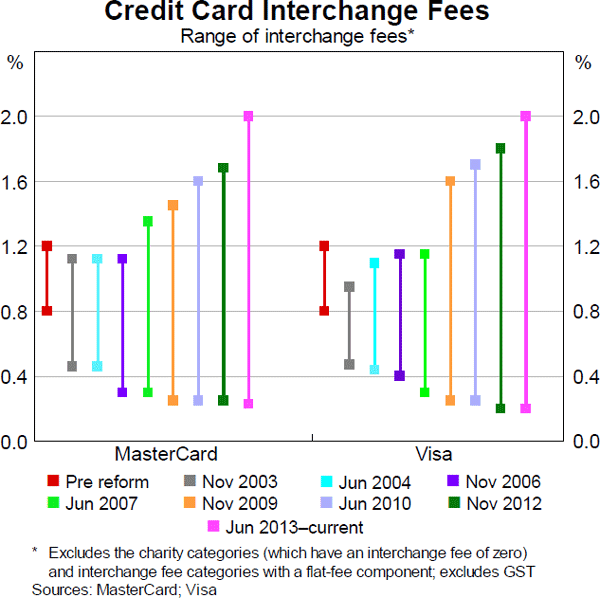
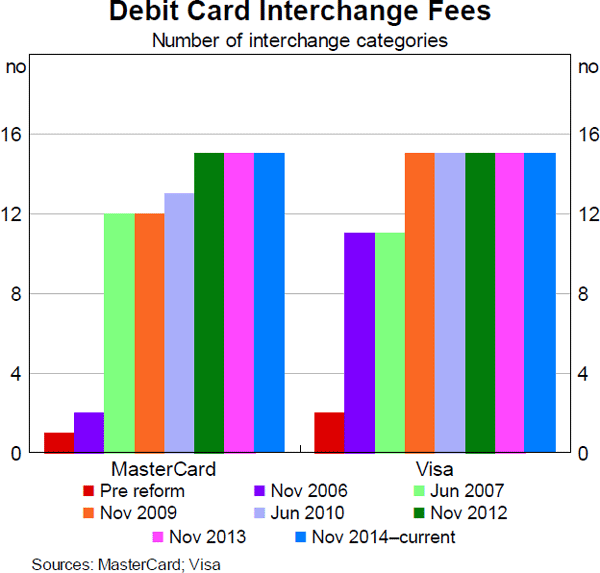
Merchant Service Fees
Average merchant service fees for MasterCard and Visa transactions have fallen by 63 basis points relative to their levels prior to the reforms (Graph 11). This is a larger fall than the reduction in interchange fees for the MasterCard and Visa credit card systems. Despite there being no direct regulation of the ‘three-party’ schemes, merchant service fees in these systems have also fallen, with the decline in American Express' fees slightly larger than that of MasterCard and Visa. Average merchant service fees for eftpos transactions have risen by around 12 cents (or by 0.20 per cent of transaction value) from their levels prior to the start of the eftpos interchange fee reforms in 2006, although eftpos remains the lowest cost scheme for merchants in terms of average merchant service fees.[8]
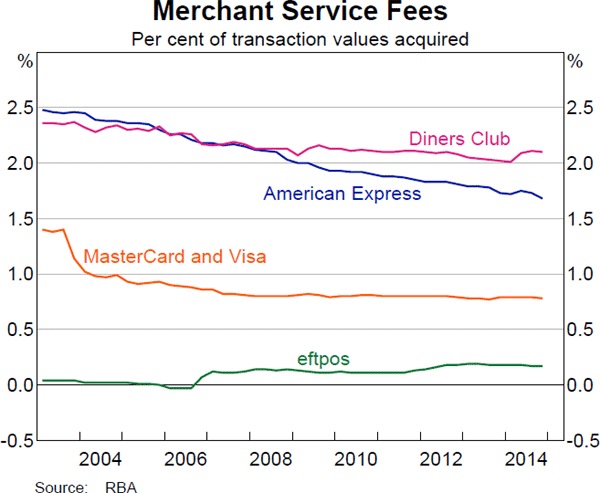
Combining transactions across all card systems, average merchant service fees in Australia have fallen by around 38 basis points from their level prior to the Bank's reforms. Furthermore, the latest available annual data show that average merchant service fees are around 74 basis points lower than in the United States, where reforms to card systems have been much more limited (Graph 12).
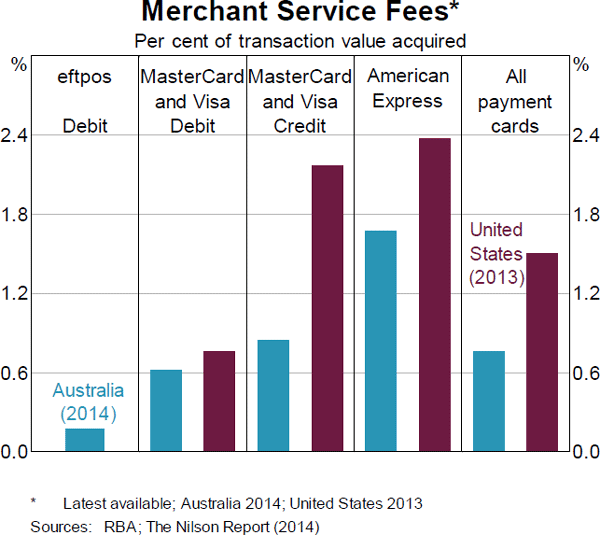
Overall, the effect of the reforms has clearly been a reduction in merchant costs: one simple estimate of these savings is a total of around $13 billion relative to the amount merchants would have paid since November 2003 if merchant service fees had remained at the rates existing prior to the reforms.[9] To the extent that interchange fees might have risen significantly in the absence of the Bank's reforms, any estimate of the savings to merchants would be far larger. For example, if average merchant service fees on card payments in Australia had instead risen to the levels seen in the absence of interchange regulation in the United States, annual costs to Australian merchants would now be around $4–4½ billion higher than current levels.[10]
It is impossible – given the imprecision in any econometric model of consumer price inflation – to measure exactly how these reductions in merchant service fees have flowed through into prices for consumers. However, just as with reductions in any other business costs – such as wages, taxes, the cost of energy, etc – that influence the prices charged by business in any industry, it seems reasonable to assume that they have mostly flowed through to lower retail prices for consumers, just as it is reasonable to assume that increases in merchant costs are similarly passed on to consumers over time. While the presumption that interchange rates influence the retail prices for goods and services faced by consumers has been questioned by the international schemes and in studies funded by them, it has been widely accepted by others (see for example, FSI (1997), p 396; Vickers (2005), p 233; FSI (2014b), p 173; European Commission (2014), p 14).
Payment Costs
The Bank has conducted two comprehensive studies of the aggregate resource costs (the economic resources that are expended to ‘produce’ a payment) incurred by financial institutions and merchants in accepting payments from consumers.[11] The results suggest that the costs involved in providing payment services to households have fallen from 0.80 per cent of GDP in 2006 to 0.54 per cent of GDP in 2013. Based on the most recent estimate, it appears that Australia now has a relatively low cost payments system by international standards. The fall between the two surveys reflects per transaction costs having fallen across most instruments. Marginally offsetting this effect, there was a shift towards greater use of more expensive instruments between the studies.
Direct debit was the lowest cost of all methods considered in the 2013 study, while cheques were the most expensive. Among the methods typically used at the point of sale, cash and eftpos were the least costly in 2013, with cash having become slightly more expensive as its use has declined and eftpos having become less expensive. Cash, eftpos and contactless MasterCard and Visa debit were estimated to have broadly similar resource costs for transactions of under about $20 (Graph 13). Above $20, eftpos was the lowest cost point-of-sale payment method. MasterCard and Visa debit card payments were more resource intensive than eftpos, while credit card transactions were the most resource intensive card payment method even when excluding the costs of credit and rewards.
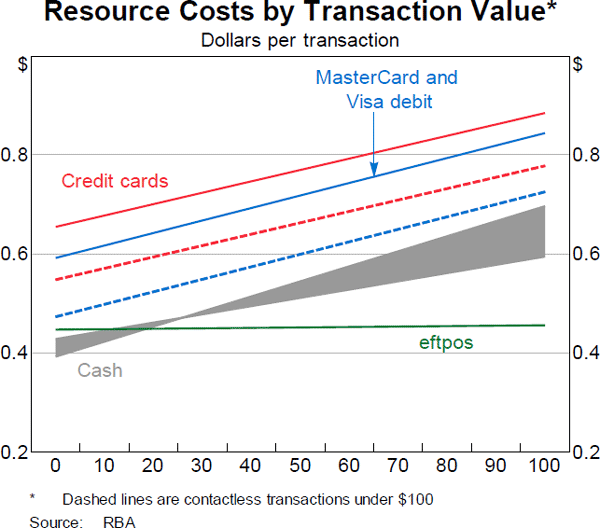
Given that decision-making by consumers and merchants is not driven by resource costs, but rather the private costs and benefits that these groups face, the 2013 study also considered the effect of fees and other transfers between consumers, merchants and financial institutions. This issue is most relevant in the case of credit cards, where consumers pay fees for cards but also receive significant incentives to use them to make purchases, due to rewards points and the interest-free period. The results indicate that on average the private cost to consumers of using a credit card is similar to that for a debit card despite the significantly higher resource costs incurred for credit card transactions.
Footnotes
See Emery, West and Massey (2008), Bagnall, Chong and Smith (2011) and Ossolinski, Lam and Emery (2014). [1]
For example, debit card transactions are included in the MasterCard and Visa data prior to March 2008, resulting in a series break. [2]
An ANZ-issued Diners Club card was launched in 2004 and may have contributed to the shift in market share at this time. Presently, Citibank issues a Diners Club card where the cardholder has the option of a companion MasterCard card. [3]
Cardholders who pay their credit card balance in full before the interest-free period expires are typically called ‘transactors’; those who regularly carry outstanding balances and thus pay interest on their credit cards are ‘revolvers’. [4]
If ‘gold’ cards are treated as having premium status, the fourth quartile (that is, the highest-income quartile) is six times more likely to hold a ‘premium’ card than the first quartile; including only ‘platinum’ and ‘super-premium’ products, holdings of the fourth quartile are 10 times larger. [5]
Previously, some institutions charged for eftpos (but not international scheme debit) transactions, reflecting the cost to issuers arising from the eftpos interchange fee which at the time flowed from issuer to acquirer. [6]
This range excludes the rate for charities, which is zero. All interchange rates quoted in the paper are excluding GST. [7]
The increase in the cost of eftpos reflects the regulated reduction of eftpos interchange fees in 2006 and the subsequent reversal of their direction after the eftpos interchange cap was aligned with that of the Visa Debit system in 2010. While fees to merchants have risen, the change in interchange arrangements means – as would be suggested by ‘Box A: Interchange Fees’ – that fees to account holders for eftpos transactions have tended to fall. Previously, many account holders had monthly limits on the number of fee-free eftpos transactions they could make in a month: such transactions are now typically unlimited. [8]
Similar estimates can be obtained from comparing total merchant service fees paid between November 2003 and December 2014 for observed transaction volumes to two counterfactuals which both assume that average merchant service fees had remained at their starting level: the first scenario is based on the actual progression of each scheme's share of the total value of card transactions; while the second scenario assumes that schemes' market shares remained at their starting levels. [9]
The calculation takes the number and value of card transactions acquired in Australia and applies US merchant service fees. The US merchant service fee data are from The Nilson Report (2014) for the latest available year (2013) except in the case of debit cards, where pre-Durbin Amendment merchant service fees (2010) are assumed (The Nilson Report 2011). The implied average of merchant service fees for the United States is 1.70 per cent, compared with the actual average for Australia of 0.73 per cent. [10]
See Schwartz et al (2008) and Stewart et al (2014) [11]